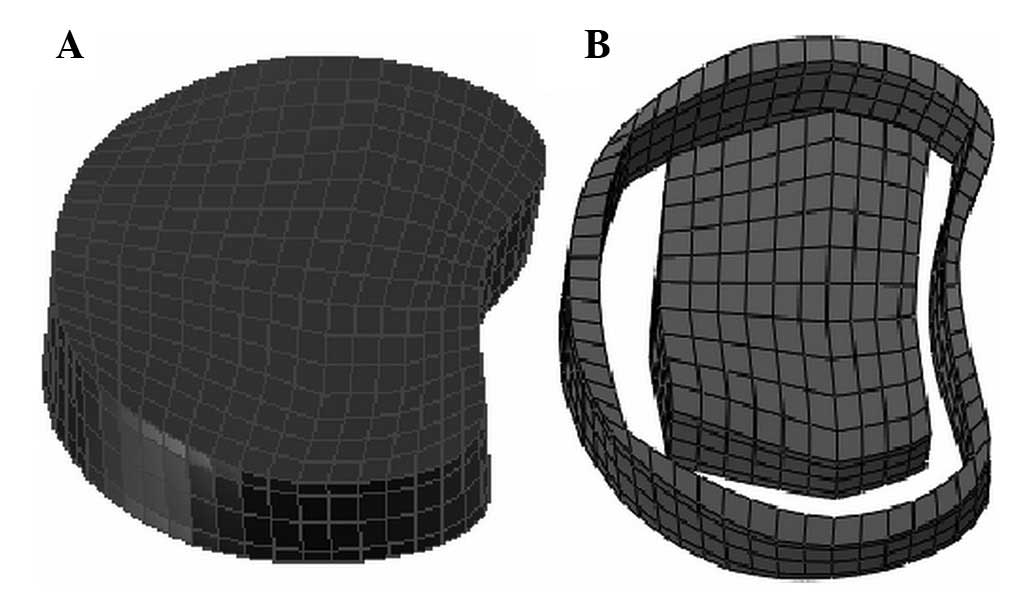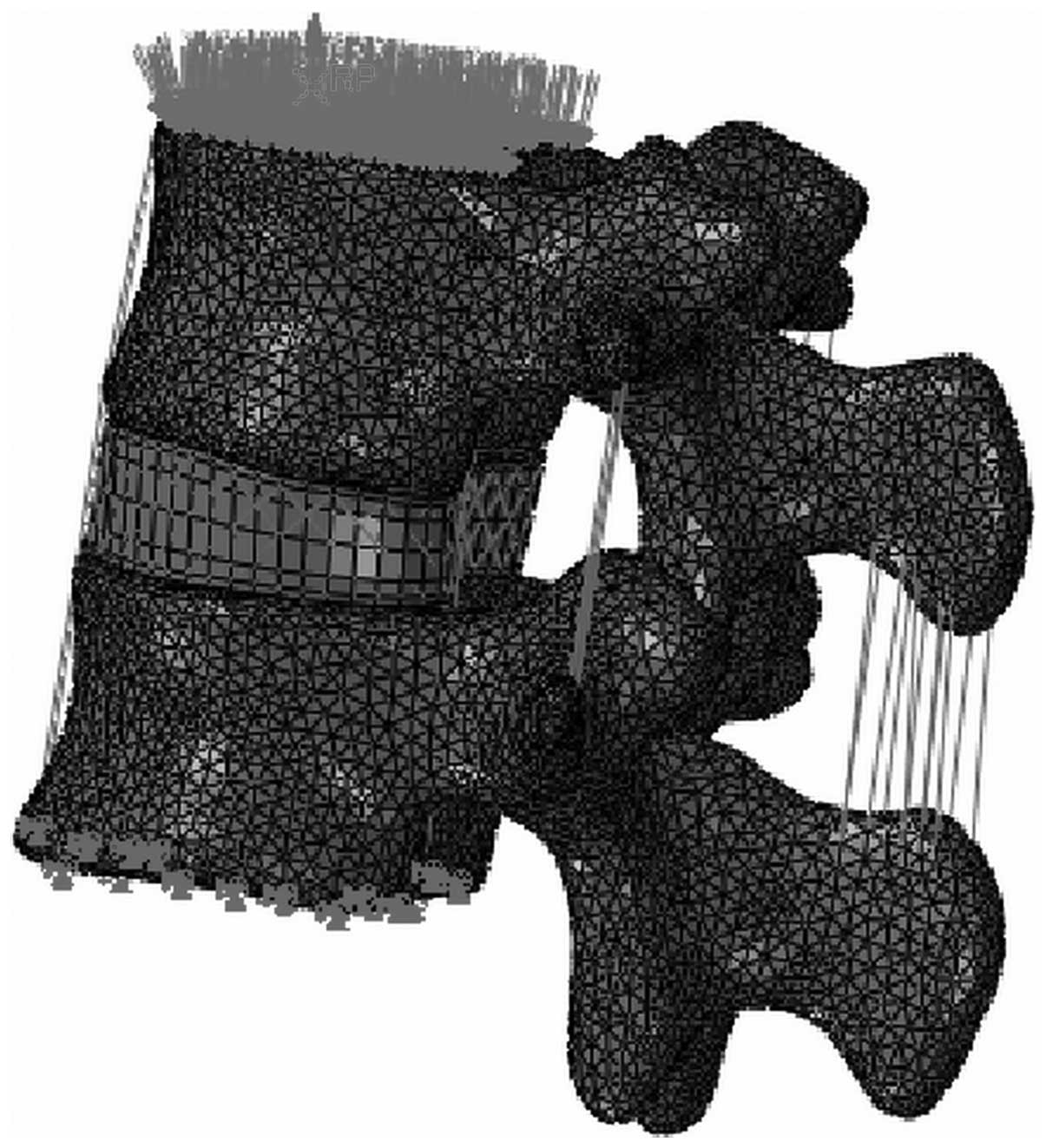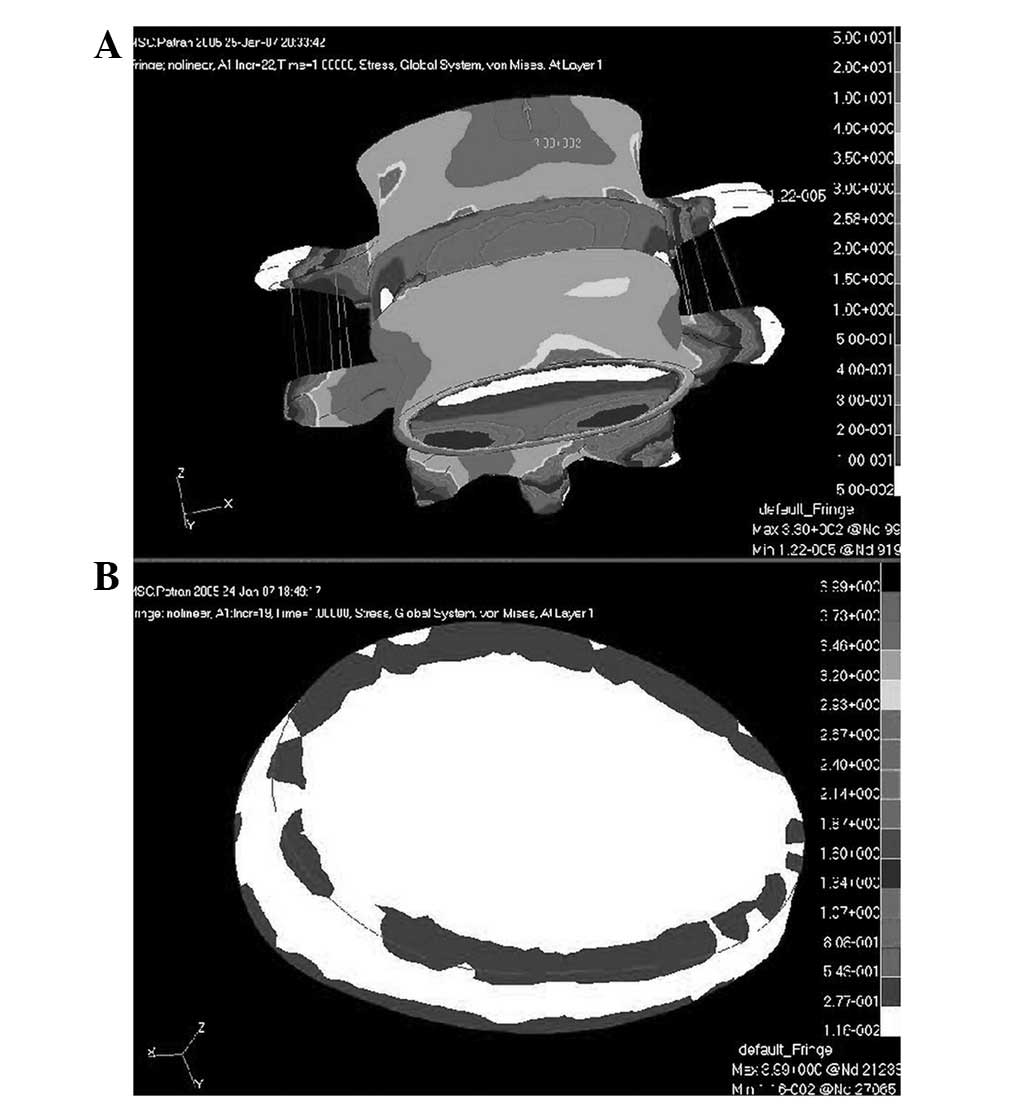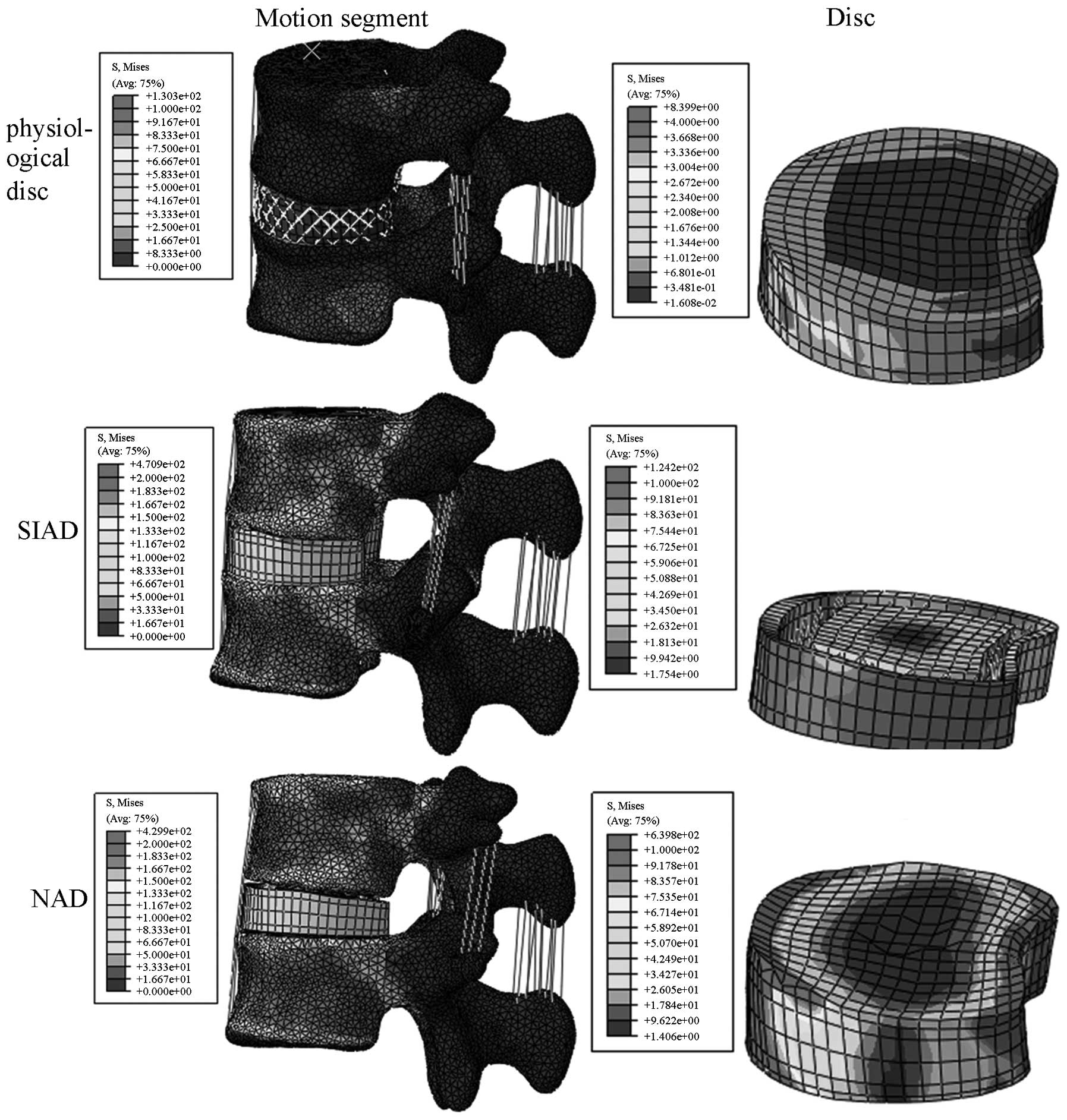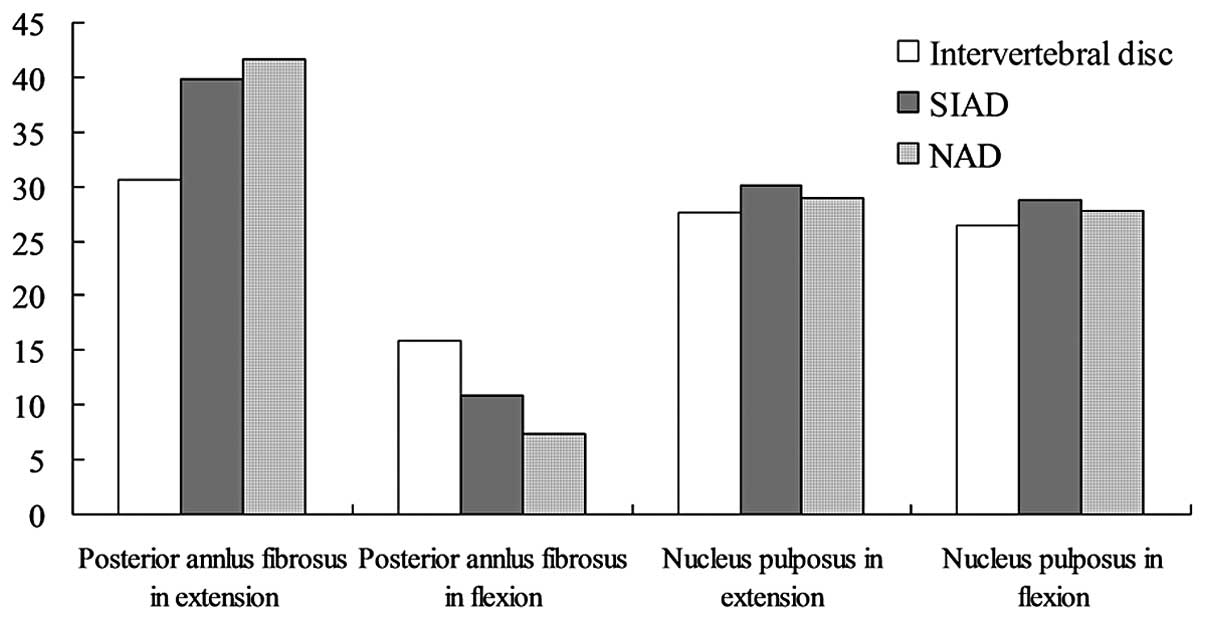|
1
|
Swanson KE, Lindsey DP, Hsu KY, Zucherman
JF and Yerby SA: The effects of an interspinous implant on
intervertebral disc pressures. Spine (Phila Pa 1976). 28:26–32.
2003. View Article : Google Scholar : PubMed/NCBI
|
|
2
|
Sengupta DK: Dynamic stabilization devices
in the treatment of low back pain. Neurol India. 53:466–474. 2005.
View Article : Google Scholar : PubMed/NCBI
|
|
3
|
Shono Y, Kaneda K, Abumi K, McAfee PC and
Cunningham BW: Stability of posterior spinal instrumentation and
its effects on adjacent motion segments in the lumbosacral spine.
Spine (Phila Pa 1976). 23:1550–1558. 1998. View Article : Google Scholar : PubMed/NCBI
|
|
4
|
Meyers KN, Campbell DA, Lipman JD, et al:
Dynamics of an intervertebral disc prosthesis in human cadaveric
spines. HSS J. 3:164–168. 2007. View Article : Google Scholar : PubMed/NCBI
|
|
5
|
Ha SK, Kim SH, Kim DH, Park JY, Lim DJ and
Lee SK: Biomechanical study of lumbar spinal arthroplasty with a
semi-constrained artificial disc (Activ L) in the human cadaveric
spine. J Korean Neurosurg Soc. 45:169–175. 2009. View Article : Google Scholar : PubMed/NCBI
|
|
6
|
Austen S, Punt IM, Cleutjens JP, et al:
Clinical, radiological, histological and retrieval findings of
Activ-L and Mobidisc total disc replacements: a study of two
patients. Eur Spine J. 4:S513–S520. 2012. View Article : Google Scholar : PubMed/NCBI
|
|
7
|
Rohlmann A, Mann A, Zander T and Bergmann
G: Effect of an artificial disc on lumbar spine biomechanics: a
probabilistic finite element study. Eur Spine J. 18:89–97. 2009.
View Article : Google Scholar : PubMed/NCBI
|
|
8
|
Kim KT, Lee SH, Suk KS, Lee JH and Jeong
BO: Biomechanical changes of the lumbar segment after total disc
replacement: Charite®, Prodisc® and
Maverick® using finite element model study. J Korean
Neurosurg Soc. 47:446–453. 2010. View Article : Google Scholar : PubMed/NCBI
|
|
9
|
Yao QQ, Wang LM, Gui JC, et al: Three
dimension finite element model of the earlier-period degeneration
lumbar motion segments reconstructed from CT images. Acta
Universitatis Medicinalis Nanjing. 27:1084–1087. 2007.(In
Chinese).
|
|
10
|
Goto K, Tajima N, Chosa E, et al: Effects
of lumbar spinal fusion on the other lumbar intervertebral levels
(three-dimensional finite element analysis). J Orthop Sci.
8:577–584. 2003. View Article : Google Scholar : PubMed/NCBI
|
|
11
|
Yamamoto I, Panjabi MM, Crisco T and
Oxland T: Three-dimensional movements of the whole lumbar spine and
lumbosacral joint. Spine (Phila Pa 1976). 14:1256–1260. 1989.
View Article : Google Scholar : PubMed/NCBI
|
|
12
|
Fujiwara A, Lim TH, An HS, et al: The
effect of disc degeneration and facet joint osteoarthritis on the
segmental flexibility of the lumbar spine. Spine (Phila Pa 1976).
25:3036–3044. 2000. View Article : Google Scholar : PubMed/NCBI
|
|
13
|
Aghayev E, Röder C, Zweig T, Etter C and
Schwarzenbach O: Benchmarking in the SWISSspine registry: results
of 52 Dynardi lumbar total disc replacements compared with the data
pool of 431 other lumbar disc prostheses. Eur Spine J.
19:2190–2199. 2010. View Article : Google Scholar : PubMed/NCBI
|
|
14
|
Chou WY, Hsu CJ, Chang WN and Wong CY:
Adjacent segment degeneration after lumbar spinal posterolateral
fusion with instrumentation in elderly patients. Arch Orthop Trauma
Surg. 122:39–43. 2002. View Article : Google Scholar : PubMed/NCBI
|
|
15
|
McMillan DW, McNally DS, Garbutt G and
Adams MA: Stress distributions inside intervertebral discs: the
validity of experimental ‘stress profilometry’. Proc Inst Mech Eng.
210:81–87. 1996.PubMed/NCBI
|
|
16
|
Simpson EK, Parkinson IH, Manthey B and
Fazzalari NL: Intervertebral disc disorganization is related to
trabecular bone architecture in the lumbar spine. J Bone Miner Res.
16:681–687. 2001. View Article : Google Scholar : PubMed/NCBI
|
|
17
|
Whitecloud TS 3rd, Castro FP Jr, Brinker
MR, Hartzog CW Jr, Ricciardi JE and Hill C: Degenerative conditions
of the lumbar spine treated with intervertebral titanium cages and
posterior instrumentation for circumferential fusion. J Spinal
Disord. 11:479–486. 1998.
|
|
18
|
Schmidt R, Obertacke U, Nothwang J, et al:
The impact of implantation technique on frontal and sagittal
alignment in total lumbar disc replacement: a comparison of
anterior versus oblique implantation. Eur Spine J. 19:1534–1539.
2010. View Article : Google Scholar : PubMed/NCBI
|
|
19
|
Katsimihas M, Bailey CS, Issa K, et al:
Prospective clinical and radiographic results of CHARITÉ III
artificial total disc arthroplasty at 2- to 7-year follow-up: a
Canadian experience. Can J Surg. 53:408–4145. 2010.
|
|
20
|
Vicars R, Hyde PJ, Brown TD, et al: The
effect of anterior-posterior shear load on the wear of ProDisc-L
TDR. Eur Spine J. 19:1356–1362. 2010. View Article : Google Scholar : PubMed/NCBI
|
|
21
|
Schmidt H, Midderhoff S, Adkins K and
Wilke HJ: The effect of different design concepts in lumbar total
disc arthroplasty on the range of motion, facet joint forces and
instantaneous center of rotation of a L4–5 segment. Eur Spine J.
18:1695–1705. 2009.PubMed/NCBI
|
|
22
|
Robinson Y and Sandén B: Spine imaging
after lumbar disc replacement: pitfalls and current
recommendations. Patient Saf Surg. 3:152009. View Article : Google Scholar : PubMed/NCBI
|
|
23
|
Berg S, Tullberg T, Branth B, Olerud C and
Tropp H: Total disc replacement compared to lumbar fusion: a
randomised controlled trial with 2-year follow-up. Eur Spine J.
18:1512–1519. 2009.PubMed/NCBI
|
|
24
|
Sasso RC, Foulk DM and Hahn M:
Prospective, randomized trial of metal-on-metal artificial lumbar
disc replacement: initial results for treatment of discogenic pain.
Spine (Phila Pa 1976). 33:123–131. 2008. View Article : Google Scholar
|
|
25
|
Nie WZ, Zhang XA and Wang CT: Biomechanics
Research on Artificial Disk of Maverick. Beijing Biomedical
Engineering. 28:4–7. 2009.(In Chinese).
|
|
26
|
Valdevit A and Errico TJ: Design and
evaluation of the FlexiCore metal-on-metal intervertebral disc
prosthesis. Spine J. 4:276S–288S. 2004. View Article : Google Scholar : PubMed/NCBI
|
|
27
|
Yue JJ, Bertagnoli R, McAfee PC and An HS:
Motion Preservation Surgery of the Spine. 1st edition. Elsevier;
Philadelphia, PA: pp. 25–28. 2008
|
|
28
|
Nie L, Hou Y and Cheng L: Spinal motor
function reconstruction surgery-spinal non-fusion theory and
surgical techniques. Shandong Science and Technology Press; Jinan:
pp. 91–95. 2008, (In Chinese).
|
|
29
|
Nie L, Hou Y and Cheng L: Spinal motor
function reconstruction surgery-spinal non-fusion theory and
surgical techniques. Shandong Science and Technology Press; Jinan:
pp. 84–91. 2008, (In Chinese).
|
|
30
|
McNally D, Naylor J and Johnson S: An in
vitro biomechanical comparison of Cadisc™-L with natural lumbar
discs in axial compression and sagittal flexion. Eur Spine J.
21(Suppl 5): S612–S617. 2012.PubMed/NCBI
|
|
31
|
Yue JJ, Bertagnoli R, McAfee PC and An HS:
Chapter 3. Motion Preservation Surgery of the Spine. 1st edition.
Elsevier; Philadelphia, PA: pp. 29–31. 2008
|
|
32
|
Moumene M and Geisler FH: Comparison of
biomechanical function at ideal and varied surgical placement for
two lumbar artificial disc implant designs: mobile-core versus
fixed-core. Spine (Phila Pa 1976). 32:1840–1851. 2007. View Article : Google Scholar : PubMed/NCBI
|
|
33
|
Rohlmann A, Mann A, Zander T and Bergmann
G: Effect of an artificial disc on lumbar spine biomechanics: a
probabilistic finite element study. Eur Spine J. 18:89–97. 2009.
View Article : Google Scholar : PubMed/NCBI
|
|
34
|
Zhong ZC, Wei SH, Wang JP, Feng CK, Chen
CS and Yu CH: Finite element analysis of the lumbar spine with a
new cage using a topology optimization method. Med Eng Phys.
28:90–98. 2006. View Article : Google Scholar : PubMed/NCBI
|
|
35
|
Zhong ZC, Wei SH, Wang JP, Feng CK, Chen
CS and Yu CH: Finite element analysis of the lumbar spine with a
new cage using a topology optimization method. Med Eng Phys.
28:90–98. 2006. View Article : Google Scholar : PubMed/NCBI
|





